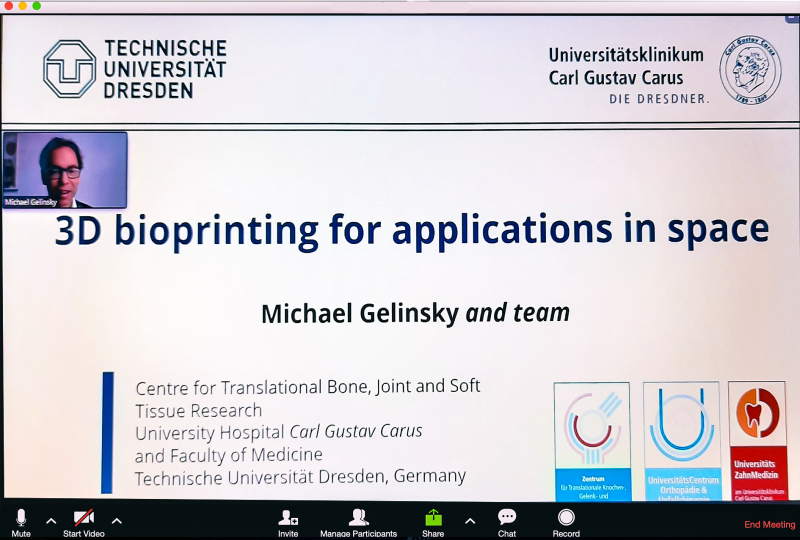Molecular Biology and Biotechnology
My Experience of Attending the BioPrint Workshop Remotely
The year 2020 has been quite unusual. Despite the odds, ITMO University’s Solution Chemistry of Advanced Materials and Technology (SCAMT) Institute had recently organized a workshop on 3D bioprinting called BioPrint and I being placed in a different country had to attend it completely online. But in no way was the workshop unidirectional. All of us got the opportunity to interact with the scientists and ask them questions about their research. I felt I was a part of the event throughout even though physically I was miles away.

The BioPrint workshop was jointly organized by Eugenia Kumacheva from University of Toronto and Sofia Morozova and Aleksandra Ignatenkova from ITMO University. The two-day workshop included fascinating lectures on the latest advances in bioprinting from leading experts across the globe and a half-day hands-on experience in the laboratory for the participants. The topics of discussion ranged over a wide spectrum of research: from in vivo bioprinting to 3D bioprinting for applications in space.
The first day of the workshop started with a detailed talk by Dr. Zhihong Nie from Shanghai, China (Fudan University) who walked us through the concepts of interaction between ink particles and colloid compounds. His work demonstrated in a very simplified manner how nanoparticles interact in a way similar to atomic interactions obeying the laws of stoichiometry through electrostatic interactions.

I was really amazed by the talk of Dr. Leonid Ionov from University of Bayreuth, Germany who showed us how biomaterials fold under certain conditions like change in pH and temperature. He took inspiration from nature and developed biomaterials which can achieve numerous shapes and sizes in-vivo. A technology such as this one would find immense applications in the medical industry as products made out of such biomaterials would be very elastic as well as biocompatible.
My favourite talk was by Dr. Michael Gelinsky from Technische Universitat Dresden, Germany who discussed the potential applications of 3D bioprinting in a microgravity environment. Being an enthusiast in space biotechnology, I was thrilled to learn the ongoing bioprinting experiments onboard the International Space Station. Using an extrusion printer, Dr. Gelinsky has already performed quite a few bioprinting experiments under simulated microgravity conditions.

The second day of the workshop commenced with a hands-on workshop for the participants. Unfortunately, I was unable to attend it as I was attending it online, miles away from St. Petersburg. I got to know from my friends who attended it that the hands-on session was divided into four segments with the objective to demonstrate the applications of bioprinting to the participants. The four segments respectively were: introductory session, rheology, computer modelling of patterns, and 3D bioprinting using the 3D printer in the SCAMT lab.
The participants had two major tasks to perform in the lab:
- Print a wound dressing that exhibits pH sensitivity and an antibacterial effect, or;
- Print a pattern with micro- and nanoarchitecture using fluorescent dye-based ink and use it to write their own message.

After the hands-on session there was a lecture by Dr. Sergei Sheiko from University of North Carolina- Chapel Hill, USA. His talk focused on novel bioprinting ink design which would provide more porosity to the biomaterial. This would enhance its use in-vivo because these pores help in the growth of blood vessels through the biomaterial thus maintaining vascularity.
The final lecture of the workshop was delivered by Dr. Eugenia Kumacheva from the University of Toronto. She described the latest achievements in the field of 3D printing that are related to the development of nanoscience and polymeric materials. Her talk also focused on the development of 3D printing ink and its biological applications.

Bioprinting is a field that is growing rapidly and has a variety of applications capable of having a lasting impact on the world. Ongoing research around the world is currently aiming to develop an efficient bioprinting paradigm that could be used to create smart materials like stimuli-responsive polymers, components for soft robotics, 3D-printed flexible electronics, and bioactive polymer composites. Bioprinting also finds its application in the food industry and the nano-pharmaceutical industry. I was fortunate enough to be a part of this workshop where I learned about the latest achievements in the field of bioprinting. I am thankful to ITMO University for organizing this workshop and giving us an opportunity to interact with scientists from all over the world who are involved in this field. I believe the day is not too far when entire organs would be bioprinted for patients who need an organ transplant!
